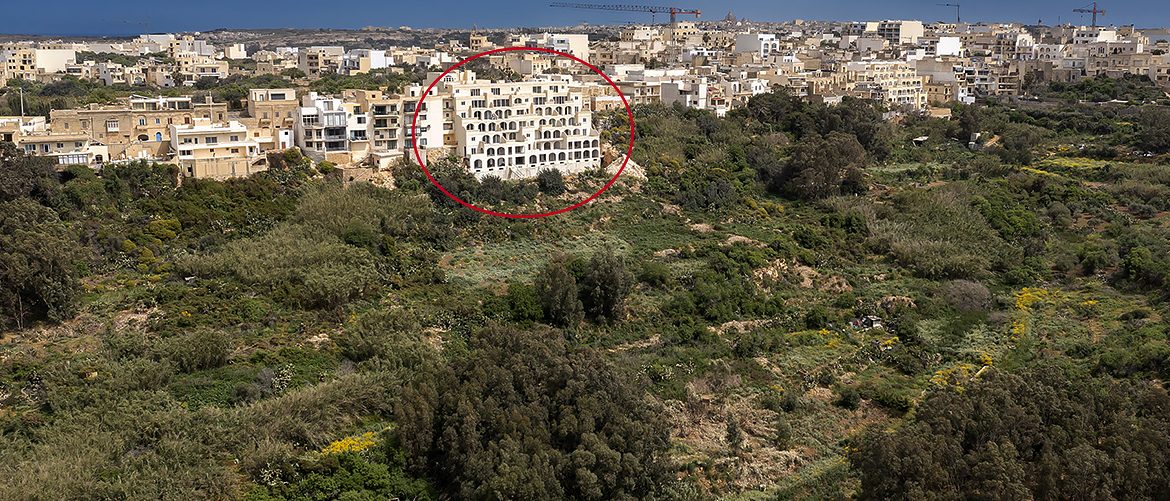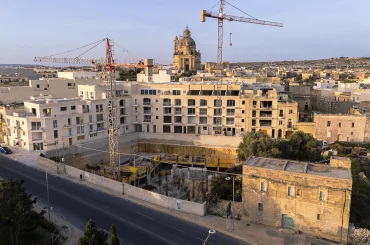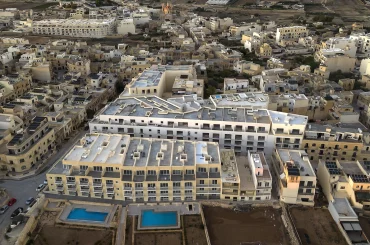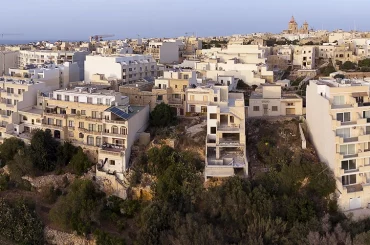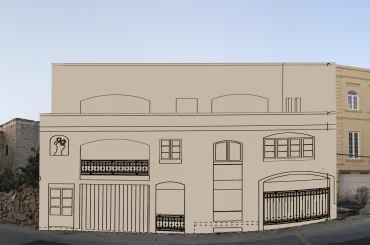As Labour Party figures call for investigations and the NGO Repubblika wrote to the environment commissioner within the ombudsman’s office to investigate, an extensive review by this website has found that the Planning Commission’s rationale for approving a contentious swimming pool in Xaghra to be based on an apparently false or wrong premise. This week’s Planning Commission’s decision also disregarded legal principle and various judgements of the Court of Appeal.
No commitment can ever take precedence over refusal of permit on basis of law, plan or policy.
Court of Appeal

The pool, set below a ridge on the side of the valley, is the most blatant of its type yet in Gozo since the publication of the Local Plan in 2006, when policies on ridge-edge developments were published for the first time.
Approval of the pool last Tuesday has caused an outcry. Many critics, including Xaghra mayor Christian Zammit, expressed concern about the precedent the decision sets for other pools along the same ridge – and other ridges in Gozo. A video published on JournalismPlus’ YouTube channel demonstrates the impact that pools would have on the ecology and scenery of this highly-sensitive ridge and lush valley.
The swimming pool and the 8-level block of 24 flats belong to Excel Investments Limited, which is owned by Joseph Portelli (majority shareholder), the Agius brothers (Ta Dirjanu) and Daniel Refalo.
In its review, this website scrutinized hundreds of pages of documents – planning case files, laws, court judgements, and policy documents. Here are the main findings:
False premise
The policy on swimming pools says that swimming pools “adjacent to ridge edges” on sites beyond the development zone can only be allowed if “it can be proven that these interventions are occurring on existing (permitted) established gardens, and the intervention complements the sensitive characteristics of the ridge edge.”
The Planning Commission addressed the first of these two policy stipulations by stating that the pool “is also being shifted closer to the building and also to occupy part of the backyard already approved in previous permit.”
The “previous permit” refers to the permit for the 8-level building, which is already completed. But a planning expert who scrutinized the case file told this website that there was no backyard in that application – hence none could have been approved.
This is also evident from the photo montage submitted by the architect as one of the documents requested for processing that application (the building was granted permit in 2019). The photo montage shows the then-proposed building set in the lush maquis vegetation and trees that at the time existed on site.

The vegetation at the back was then cleared, and all trees destroyed, prior to the construction of the building. At the time, the Planning Authority told this website that the land was “disturbed in relation to geological surveying required to establish the structural stability of the proposed foundations. Such intervention is permissible in terms of Class 13 of the Development Notification Order (2016) and the land needs to be restored to its original state.”
But pictures taken during the construction show that the cleared land – not only was it disturbed; several mature protected trees were also destroyed – was used as staging ground during the construction.

And afterwards the land was left cleared, with heaps of unsightly rubble, not restored.
It is on this land that the pool approved by the Planning Commission now sits on.
Design committee ignored
The second for allowing ridge-edge swimming pools holds that these have to “complement the sensitive characteristics of the ridge edge.” The Planning Commission addressed this point by saying that the “layout as amended is considered to respect the terracing effect of the ridge and it will be integrated and screened within the proposed landscaped area.”
Yet the committee within the Planning Authority that assesses points of design and aesthetics, the Design Advisory Committee, had written in its assessment that “the proposal would have an adverse impact on the valley.”

The Planning Commission then asked from some tweaks – adding six trees, having a terraced landscaped section, reducing pool by around a fifth in size – and then granted permit. In this way, the Planning Commission implicitly decided that such tweaks voided the objection of the Design Advisory Committee without asking that committee for a reassessment. The commission did not even address the committee’s adverse assessment in any of its minutes.
Court teachings unheeded
In another attempt to justify its decision, the Planning Commission wrote in the minutes: “Reference was also made to block plan 213C indicating commitments of similar developments along same stretch of street where same policies apply and which are considered a material planning consideration on basis of Article 72D of the Development Planning Act 2016.”
Document 213C makes reference to, and comparison with, another pool at the back of another block of flats 200 metres up the road. The Planning Commission here invoked Article 72 (2) (d) of the planning act, which says that in deciding on a planning application, the commission “shall have regard” to material considerations “including surrounding legal commitments.”

Yet the pool at the back of the block 200 metres up the road was initially granted in 2004. That permit was then amended a few times, but the pool outback and the perimeter or spread remained the same.
The policy on pools on ridges, on the other hand, was published in 2006.
As such, to latch onto a similar permit granted before the policy was published and then use that permit to make an exception from the policy that was designed to put a halt to those permits displays a disregard for policy and law. Such reasoning would render changes in policy meaningless, and makes the Planning Commission’s decision highly arbitrary, or an abuse of discretion.
Chief Justice Mark Chetcuti dealt with this point in the Court of Appeal (Michael Debrincat vs L-Awtorita tal-Ippjanar) when he wrote that “no commitment can ever take precedence over refusal of permit on basis of law, plan or policy. In fact Article 72 (2) of Cap 552 holds that the Board [Planning Commission] has to consider first and foremost plans and policies brought before it and has to consider other substantial element including commitments… The emphasis of the legislator is on adherence to laws, plans and policies and other factors [including commitments] are taken into consideration for as long as these do not derail laws, plans, and policies applicable for the [specific planning application] case.”
In a later, separate judgement (Winston J. Zahra vs L-Awtorita tal-Ippjanar), the Court of Appeal reiterated this point: “The Court again makes it clear in this appeal that when the legislator is clear and does not allow discretion of interpretation or diverse treatment, the [Planning] Authoirty, Tribunal and Court are bound with what the legislator wants. The Court adds that the [Planning] Authority in the first instance and the Tribunal as an authority of revision have to ensure that these principles are observed because, in the view of the court, this is the only way to assure a level playing field among applicants, and any shadow of suspicion of discrimination or favouritism [from] being raised.”
Donate to Planning Emergency
The investigative articles into perverse planning or damaging development published on this website take time, resources, and effort to put together. These articles make impact by the robustness of the research and the professionalism of the reportage. Your support is needed to sustain this kind of impactful reportage. This website's donation setup itself is uniquely transparent, with targeted amounts that allow tracking of donations in real time. Contribute as little as €5 to sustain active planning journalism that makes an impact.

